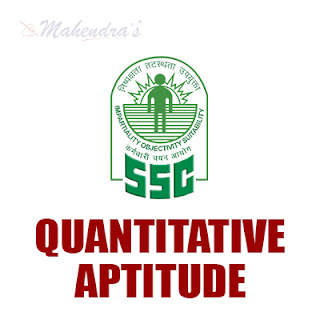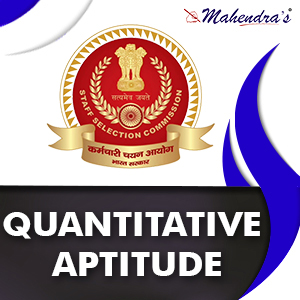In SSC exam, quantitative Aptitude section is more scoring and easy, if you know the shorts tricks and formulas of all the topics. So, it is important to know the basic concepts of all the topics so you can apply the short tricks and solve the question with the new concepts in lesser time while giving the quiz. It will help you to score more marks from this section in less time period. Quantitative Aptitude section basically measures your mathematical and calculation approach of solving the question. SSC Quiz of quantitative Aptitude section helps you to analyse your preparation level for upcoming SSC examination. Mahendra Guru provides you Quantitative Aptitude Quiz for SSC examination based on the latest pattern so that you can practice on regular basis. It will definitely help you to score good marks in the exam. It is the most important section for all the govt exams like Insurance, SSC-MTS, SSC CPO, CGL, CHSL, State Level, and other Competitive exams.
Mahendra Guru also provides you important notes and study material for all subject and test through its website, Mahendra Guru App and YouTube channel apart from it Speed Test Portal. Most of these preparation products are also available for purchase on my shop. You can also visit Mahendras.org to get more information about our endeavour for your success. You can also study in details through our E-Mahendras Facebook and Mahendra Guru YouTube channel of Quantitative Aptitude.
Q.1. The H.C.F of (235-1) and (25-1) is
(235-1) और (25-1) का म.स.प. है-
(A) 32
(B) 31
(C) 235
(D) 25 – 1
Q.2. If a =51/3 + 5 – 1/3 then find then value of a3 - 3a
यदि a = 51/3 + 5 – 1/3 तो a3 – 3a होगा-
(A) 26
(B) 

(C) 

(D) 

Q.3. If a +  = 49 then find the value
= 49 then find the value 
 = 49 then find the value
= 49 then find the value 
यदि a +  = 49 तो
= 49 तो  का मान होगा-
का मान होगा-
 = 49 तो
= 49 तो  का मान होगा-
का मान होगा-
(A) 

(B) 1
(C) 

(D) 0
Q.4. A parallelogram ABCD has sides AB = 24 cm. and AD = 16 cm. The distance between the sides AB and DC is 10 cm. Find the distance between the sides AD and BC.
एक समानांतर चतुर्भुज ABCD की एक भुजा AB = 24 सेमी. और AD = 16 सेमी. है। भुजाओं AB और DC की दूरी 10 सेमी. है। तदनुसार AD और BC भुजाओं के बीच की दूरी कितनी होगी?
(A) 15
(B) 18
(C) 20
(D) 26
Q.5. The radius of a circle is increased so that its circumference is increased by 5%. The area of the circle is then increases by-
एक वृत्त की त्रिज्या मे इस प्रकार वृद्धि होती है कि इसकी परिधि में 5% की वृद्धि हो जाती है, तो वृत्त के क्षेत्रफल में वृद्धि है-
(A) 12.5%
(B) 10.25%
(C) 10.5%
(D) 5.5%
Q.6. If a2 + b2 + 2b + 6a + 10 = 0, then the value of  is
is
 is
is
यदि a2 + b2 + 2b + 6a + 10 = 0 हो, तो  का मान क्या होगा?
का मान क्या होगा?
 का मान क्या होगा?
का मान क्या होगा?
(A) 6
(B) – 2
(C) 

(D) 

Q.7. The curved surface area of a cylindrical pillar is 264 m2 and its volume is 924 cm3 The ratio of its diameter to height is:
किसी बेलनाकार स्तंभ के वक्र तल का क्षेत्रफल 264 मी2. है और उसका आयतन 924 सेमी3. है। तदनुसार उसके व्यास और ऊँचाई का अनुपात कितना होगा?
(A) 3: 7
(B) 7: 3
(C) 6: 7
(D) 7: 6
Q.8. A shopkeeper gain Rs. 56 on a toy after allowing 23% discount on its marked price. If his gain is 10%, then the marked price of the toy is:
एक दुकानदार एक खिलौने के अंकित मूल्य पर 23% छूट देकर 56 रू. का लाभ प्राप्त करता है। यदि उसका यह लाभ 10% रहा हो, तो उस खिलौने का अंकित मूल्य कितना था?
(A) Rs.810
(B) Rs.800
(C) Rs.560
(D) Rs.740
Q.9. A fruit seller makes a profit of 20% by selling mangoes at a certain price. If he charge Rs. 1 more for each mango, he can make a profit of 40%. Find the selling price of a mango in the first case.
एक फल विक्रेता, नियत मूल्य पर आम बेचकर 20% लाभ प्राप्त कर लेता है। यदि वह उन्हीं आमों को प्रति आम 1 रू. कीमत बढ़ाकर बेचे, तो उसका लाभ 40% हो सकता है। तदनुसार एक आम का बिक्री मूल्य कितना था?
(A) Rs.6
(B) Rs.5
(C) Rs.5.5
(D) Rs.7
Q.10. A bus left with some definite number of passengers. At the first stop half the passengers left the bus 35 boarded the bus. At the second stop  th of the passengers left and 40 boarded the bus. The bus moved with 80 passengers towards its destination without stopping anywhere. How many passengers were there originally?
th of the passengers left and 40 boarded the bus. The bus moved with 80 passengers towards its destination without stopping anywhere. How many passengers were there originally?
 th of the passengers left and 40 boarded the bus. The bus moved with 80 passengers towards its destination without stopping anywhere. How many passengers were there originally?
th of the passengers left and 40 boarded the bus. The bus moved with 80 passengers towards its destination without stopping anywhere. How many passengers were there originally?
एक बस कुछ निश्चित यात्रियों को लेकर छूटती है। पहले स्टाप पर यात्रियों के आधे उतर जाते हैं तथा 35 बस में चढ़ते हैं। दूसरे स्टाप पर यात्रियों का  उतरते हैं और 40 चढते हैं। बस 80 यात्रियों को लेकर अपने गंतव्य स्थान की ओर बिना कहीं रूके चल देती है। प्रारम्भ में बस में कितने यात्री थे?
उतरते हैं और 40 चढते हैं। बस 80 यात्रियों को लेकर अपने गंतव्य स्थान की ओर बिना कहीं रूके चल देती है। प्रारम्भ में बस में कितने यात्री थे?
 उतरते हैं और 40 चढते हैं। बस 80 यात्रियों को लेकर अपने गंतव्य स्थान की ओर बिना कहीं रूके चल देती है। प्रारम्भ में बस में कितने यात्री थे?
उतरते हैं और 40 चढते हैं। बस 80 यात्रियों को लेकर अपने गंतव्य स्थान की ओर बिना कहीं रूके चल देती है। प्रारम्भ में बस में कितने यात्री थे?
(A) 40
(B) 30
(C) 50
(D) 60
ANSWER KEY:
Q1. (B) H.C.F of (235 – 1) and (25 – 1) = HCF of 235 and 25 – 1
(235 – 1) और (25 – 1) का म.स.प. = 235 और 25 – 1 का म.स.प.
= 25 – 1
= 31
Q2. (B) a = 51/3 + 5 – 1/3
a3 = (51/3
+ 5 – 1/3)3 = 5 + 5 – 1 + 3 (51/3 +
5 – 1/3)5a3 – 15a = 26
a3– 3a = 

Q3. (C) 


Q4. (A)


Q5. (B) Required % increase/अभीष्ट % वृद्धि = 

= 10.25%
Q6. (C) a2 + b2 + 2b + 6a + 10 = 0
b2 + 2b2 + 1 + a2 + 9 + 6a = 0
(b + 1)2 + (a + 3)2 = 0
b = – 1, a = – 3

Q7. (B) 





Required ratio/अभीष्ट अनुपात = 

Q8. (B) Let marked price be Rs.x/माना अंकित मूल्य x रु. है ।
Selling price/विक्रय मूल्य = Rs./ रु. 

Cost price/क्रय मूल्य = 

= 

According to the question/प्रश्नानुसार,

x = Rs.800
Q9. (A) Let selling price of 1 mango in the first case be Rs.x
माना प्रथम स्थिति में 1 आम का विक्रय मूल्य x रु. है ।
Cost price/क्रय मूल्य = 

= Rs. 

According to the question/प्रश्नानुसार,


400x = (2x + 12) × 100
4x = 2x + 12
x = Rs.6
Q10. (B) Let the original passengers be x/माना मूल रूप से यात्रियों की संख्या x है ।
After First stop/पहले स्टॉप के बाद,
Passengers/यात्री = 

After second stop/दूसरे स्टॉप के बाद = 

 = 80
= 80
x = 30







